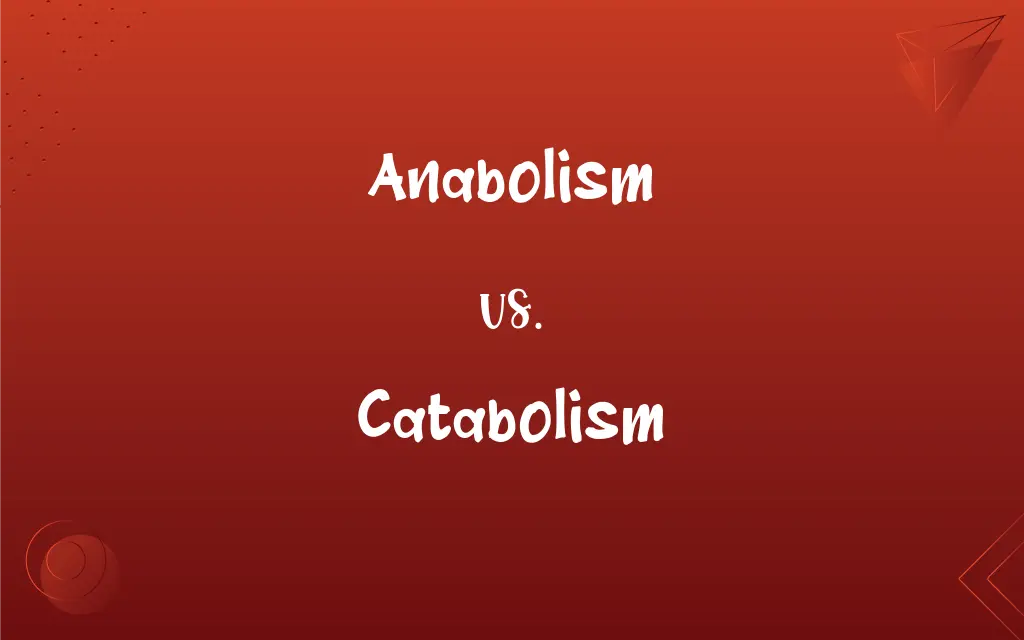Anabolism vs. Catabolism: What's the Difference?
Edited by Aimie Carlson || By Harlon Moss || Updated on October 17, 2023
Anabolism builds molecules; catabolism breaks them down.

Key Differences
Anabolism refers to the process within living organisms where simpler substances combine to form more complex ones, requiring energy, while catabolism involves the breaking down of complex substances into simpler ones, releasing energy. Both processes are continuous and vital in organisms.
Anabolism often requires energy input, typically sourced from ATP, to synthesize new compounds, whereas catabolism produces energy by breaking down compounds, often creating ATP. Both are critical for maintaining the body's energy balance.
Anabolism helps in growth and cell repair by building molecules and tissues, while catabolism aids in food digestion and waste elimination by breaking down molecules. Both are essential for overall metabolic activity and homeostasis in the body.
Anabolism is considered a constructive metabolic process due to its role in creating complex molecules from simpler ones, while catabolism is deemed destructive as it breaks down these complex molecules. Both are perpetually active in cells to maintain life.
Anabolism and catabolism are interdependent, with the energy released from catabolism driving the energy-consuming processes of anabolism, harmonizing energy use and storage in organisms.
ADVERTISEMENT
Comparison Chart
Basic Definition
Synthesizes complex molecules.
Breaks down complex molecules.
Energy
Consumes energy.
Releases energy.
Process Type
Constructive metabolism.
Destructive metabolism.
End Products
Complex molecules, tissues.
Simpler substances, waste.
Role in Body
Promotes growth and repair.
Facilitates digestion, waste elimination.
ADVERTISEMENT
Anabolism and Catabolism Definitions
Anabolism
Anabolism involves endergonic reactions.
During anabolism, energy is stored in the form of chemical bonds within new molecules.
Catabolism
Catabolism is the breakdown phase of metabolism.
In catabolism, cells break down carbohydrates to release energy.
Anabolism
Anabolism is a pathway that builds molecules the body needs.
Anabolism occurs in the liver when creating new proteins from amino acids.
Catabolism
Catabolism involves exergonic reactions.
Catabolism releases energy stored in chemical bonds.
Anabolism
Anabolism is the biosynthetic phase of metabolism.
In anabolism, cells use energy to construct complex molecules from simpler ones.
Catabolism
Catabolism is a degradative metabolic process.
Catabolism occurs during heavy exercise when muscle glycogen is broken down for fuel.
Anabolism
Anabolism requires energy to synthesize complex molecules.
Anabolism in plants involves photosynthesis, using sunlight to create glucose.
Catabolism
Catabolism generates waste products that must be eliminated.
In cellular respiration, a form of catabolism, carbon dioxide is produced as a waste product.
Anabolism
Anabolism is a constructive metabolic process.
Anabolism is crucial for bodybuilding as it helps in muscle mass growth.
Catabolism
Catabolism is a pathway that breaks down molecules to produce energy.
During starvation, catabolism breaks down muscle protein to provide energy.
Anabolism
The phase of metabolism in which simple substances are synthesized into the complex materials of living tissue.
Catabolism
The metabolic breakdown of complex molecules into simpler ones, often resulting in a release of energy.
Anabolism
The constructive metabolism of the body, as distinguished from catabolism.
Catabolism
(biochemistry) Destructive metabolism, usually including the release of energy and breakdown of materials.
Anabolism
The constructive metabolism of the body, as distinguished from catabolism.
Catabolism
The breakdown of more complex substances into simpler ones with release of energy, in living organisms; destructive or downward metabolism; - a form of metabolism, opposed to anabolism. See also Disassimilation.
Anabolism
Synthesis of more complex substances from simpler ones
Catabolism
Breakdown of more complex substances into simpler ones with release of energy
FAQs
Are anabolism and catabolism continuous processes in the body?
Yes, both anabolism and catabolism are continuous, concurrent processes essential for bodily functions.
What's catabolism?
Catabolism is the metabolic process that breaks down large molecules into smaller ones, often releasing energy.
Does anabolism occur at the same rate as catabolism?
No, the rates of anabolism and catabolism can vary based on several factors like health, activity level, and age.
What's anabolism?
Anabolism is the metabolic process that builds larger molecules from smaller ones, often requiring energy input.
What triggers catabolism?
Catabolism is often triggered by hormonal signals like cortisol, exercise, or fasting.
What role does catabolism play in weight loss?
Catabolism breaks down fat and muscle tissue, leading to weight loss.
Do anabolic reactions only occur in muscles?
No, anabolic reactions occur throughout the body, including in bones, organs, and skin.
What triggers anabolism in the human body?
Anabolism is usually triggered by growth signals, nutrient availability, and hormones like insulin.
What forms of energy does catabolism produce?
Catabolism primarily produces ATP, which is used as energy by cells.
Can you enhance anabolism naturally?
Yes, anabolism can be enhanced through proper nutrition, exercise, and adequate rest.
How are anabolism and catabolism balanced in the body?
Hormones, nutrient intake, and energy status are key regulators in maintaining a balance between anabolism and catabolism.
Can anabolism occur without catabolism?
No, anabolism and catabolism are interdependent, with catabolism providing the necessary energy for anabolism.
What's the primary energy molecule involved in anabolism?
ATP (adenosine triphosphate) is the primary energy molecule used in anabolism.
Can diseases affect anabolism and catabolism?
Yes, various diseases can disrupt the normal balance of anabolism and catabolism, affecting health.
Are anabolism and catabolism part of metabolism?
Yes, both anabolism and catabolism are two fundamental processes that together constitute metabolism.
Is catabolism a destructive process?
While it breaks down molecules, catabolism is essential for energy production and not "destructive" in a harmful sense.
How does anabolism contribute to growth in living organisms?
Anabolism synthesizes complex molecules necessary for cell and tissue growth and repair.
Does catabolism only relate to muscle breakdown?
No, catabolism involves the breakdown of various molecules in the body, not just muscle.
Can catabolic states be harmful?
Yes, excessive catabolism can lead to muscle wasting and other health issues.
Is anabolism only beneficial?
While generally beneficial for growth and repair, excessive anabolism can lead to undesirable growth or imbalances.
About Author
Written by
Harlon MossHarlon is a seasoned quality moderator and accomplished content writer for Difference Wiki. An alumnus of the prestigious University of California, he earned his degree in Computer Science. Leveraging his academic background, Harlon brings a meticulous and informed perspective to his work, ensuring content accuracy and excellence.
Edited by
Aimie CarlsonAimie Carlson, holding a master's degree in English literature, is a fervent English language enthusiast. She lends her writing talents to Difference Wiki, a prominent website that specializes in comparisons, offering readers insightful analyses that both captivate and inform.































































